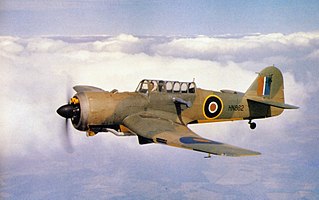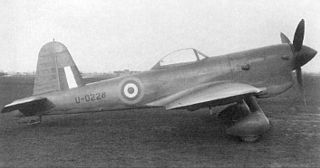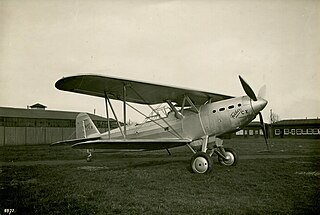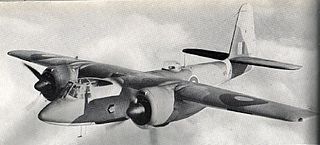Related Research Articles

The Airspeed AS.57 Ambassador is a British twin piston-engined airliner that was designed and produced by the British aircraft manufacturer Airspeed Ltd. It was one of the first postwar airliners to be produced.

The Miles M.25 Martinet was a target tug aircraft of the Royal Air Force (RAF) and Fleet Air Arm (FAA) that was in service during the Second World War. It was the first British aircraft to be designed specifically for target towing.

The Fairey Seafox was a 1930s British reconnaissance floatplane designed and built by Fairey for the Fleet Air Arm. It was designed to be catapulted from the deck of a light cruiser and served in the Second World War. Sixty-six were built, with two finished without floats and used as landplanes.

The Bristol Buckmaster was an advanced British training aircraft operated by the Royal Air Force during the 1950s.

The Curtiss-Wright AT-9 Jeep is an American twin-engined advanced trainer aircraft used by the United States during World War II to bridge the gap between single-engined trainers and twin-engined combat aircraft. The AT-9 had a low-wing cantilever monoplane configuration, retractable landing gear and was powered by two Lycoming R-680-9 radial engines.

The Hawker Henley was a British two-seat target tug derived from the Hawker Hurricane that was operated by the Royal Air Force during the Second World War.

The Miles M.20 was a Second World War British fighter developed by Miles Aircraft in 1940. It was designed as a simple and quick-to-build "emergency fighter" alternative to the Royal Air Force's Spitfires and Hurricanes should their production become disrupted by bombing expected in the anticipated German invasion of the United Kingdom. Due to the subsequent shifting of the German bombing effort after the Battle of Britain towards British cities in what became known as The Blitz, together with the dispersal of British fighter manufacturing, the Luftwaffe's bombing of the original Spitfire and Hurricane factories did not seriously affect production, and so the M.20 proved unnecessary and the design was not pursued.

The Fokker C.X was a Dutch biplane scout and light bomber designed in 1933. It had a crew of two.

The Miles M.38 Messenger is a British four-seat liaison and private owner aircraft built by Miles Aircraft.

The Miles M.33 Monitor was a twin-engined British target tug aircraft designed and built by Miles Aircraft towards the end of the Second World War. Intended for use by the Royal Air Force and the Fleet Air Arm, the aircraft did not enter service with either.

The Tachikawa Ki-54 was a Japanese, twin-engine advanced trainer used during World War II. The aircraft was named Hickory by the Allies.

The Gloster F.9/37, also known as the Gloster G.39, was a British twin-engined design from the Gloster Aircraft Company for a cannon-armed heavy fighter to serve with the Royal Air Force, planned before the Second World War. The F.9/37 was rejected in favour of other designs.

The Westland Wallace was a British two-seat, general-purpose biplane of the Royal Air Force, developed by Westland as a follow-on to their successful Wapiti. As the last of the interwar general purpose biplanes, it was used by a number of frontline and Auxiliary Air Force Squadrons. Although the pace of aeronautical development caused its rapid replacement in frontline service, its useful life was extended into the Second World War with many being converted into target tugs and wireless trainers. In 1933 a Westland Wallace became the first aircraft to fly over Everest, as part of the Houston-Mount Everest Flight Expedition.

The Avro 652 was a 1930s British light airliner, built by A.V. Roe and Company. It was a twin-engine, low-wing monoplane with a retractable undercarriage, and a tailwheel. Although only two were produced, it formed the basis for the successful Avro Anson.

The Breda Ba.64 was an Italian single-engine ground-attack aircraft used by the Regia Aeronautica during the 1930s.

The Miles M.28 Mercury was a British aircraft designed to meet the need for a training and communications plane during the Second World War. It was a single-engined monoplane of wooden construction with a twin tail and a tailwheel undercarriage with retractable main units.

The Savoia-Marchetti SM.85 was an Italian monoplane dive bomber and ground-attack aircraft that served in small numbers in the Regia Aeronautica at the beginning of World War II. They were soon replaced in service by the Junkers Ju 87.

The Fairchild AT-21 was an American World War II specialized bomber crew trainer, intended to train crews in the use of power gun turrets or a gun on a flexible mount, as well as learn to function as a member of a crew. It had a brief career as a training aircraft before modified bombers took over this role.

The Wassmer WA-40 Super 4 Sancy is a French single-engined light aircraft of the 1960s and 70s. A single-engined low-winged monoplane with retractable nosewheel undercarriage, variants include the more powerful WA 4/21 Prestige and the WA-41 Baladou with a fixed undercarriage.

The Baumann Brigadier was a prototype American light transport aircraft of the late 1940s. It was a twin-engined monoplane, which, unusually, was of pusher configuration. Only two were built, plans for production never coming to fruition.
References
- ↑ Jarrett 1991 , p. 208
- 1 2 3 4 5 6 Mondey 1994 , p. 13
- 1 2 Taylor 1970 , p. 98
- 1 2 Taylor 1970 , p. 100
- ↑ Jarrett 1991, p. 211
- Jarrett, Philip (April 1991). "Nothing Ventured...No 13". Aeroplane Monthly . Vol. 19, no. 4. pp. 208–211, 231. ISSN 0143-7240.
- Mondey, David (1994). The Hamlyn Concise Guide to British Aircraft of World War II. London: Chancellor Press. ISBN 1-85152-668-4.
- Taylor, H. A. (1970). Airspeed Aircraft since 1931. London: Putnam. ISBN 0-370-00110-9.